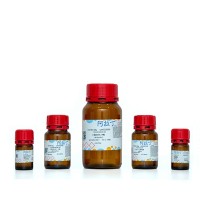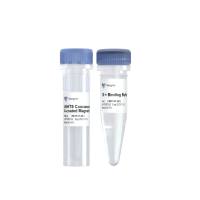Autoradiography using Emulsion-coated Coverslips
1. Cleaning coverslips
(use gloves)
-
Add 1 bottle of Chromerge, 1/5 at a time, into 2.5 L bottle of Sulfuric Acid. Invert the bottle to mix after each addition.
-
Load coverslips into glass carriers in every other slot at a slant (see fig. 1).
-
Pour enough chromic acid solution into tray to cover the tops of the coverslips. Leave overnight.
-
Take carriers out of acid and place into a tray containing about one inch of water. Do not touch the coverslips!
-
Rinse in running tap water 20 minutes, empty water and rinse again for 3 hours. Wash with 3 changes of distilled or deionized water. Place tray on a slant (to allow water to drain) into 60° C oven overnight.
-
Once the coverslips have been acid cleaned it is essential that the end which will be dipped in emulsion not be touched, and that it be as clean as possible (i.e., not the end which was in the corner of the slide carrier (see fig. 2).
-
After drying, place coverslips into black slide boxes. Touch only one end of each, and place the touched end toward the left side of the slide box.
|
<center>
<font></font>
<p>
<font>Figure 1</font>
</p>
<p>
<font></font>
</p>
<p>
<font>
Figure 2
<br />
Touch the slips only at the end markeundefined
</font>
</p>
</center>
|
2.Dipping (in a dark room)
-
Turn on water bath to 42° C.
-
Melt NTB-2 or NTB-3 emulsion (which had been diluted 1:1 with H
2
O) by placing covered 50 ml plastic Falcon tube of emulsion in a beaker of water in the water bath for about 20 minutes. Gently invert the tube of emulsion several times to mix, then slowly pour the emulsion into a coplin jar. Let the emulsion stand 20-30 minutes before use to allow air bubbles to rise. The emulsion may be mixed further with a clean slide.
-
Be sure to touch only the left side of each coverslip. Dip one coverslip and examine for air bubbles. If there are still bubbles, wait a while, then test again. If there are no bubbles, you are ready to begin.
-
Dip the coverslips (or slides) slowly to prevent forming air bubbles. Lower the coverslip until it touches the bottom of the jar. Raise slowly, and drain off the excess onto the lipof the jar (see fig. 3).
-
Hang the dipped coverslips on the clothespin rack to dry for 3 hours. Place 10-15 dried coverslips into each black box with Drierite capsules. Tape edges of the box with black photography tape. Store boxes at 4° C in a light safe.
|
<center>
<font></font>
<p>
<font>Figure 3</font>
</p>
<p> </p>
</center>
|
3.Coverslipping slides (in a dark room)
-
With the light on, draw a heavy line with a wax pencil across each slide to prevent the super glue from spreading past the end of the slide. Lay all slides face up on a reflective metalsheet or mirror. Place a drop of super glue onto the frosted end of each slide (see fig.4).
-
In the dark, open the box of coverslips and, holding the coverslips only at the undipped end, carefully place one coverslip on each slide. The emulsion coated end of the coverslip should extend about 2 mm over the end of the slide.
-
Place two slides back to back, place one glass square on the coverslip over the issue on each side, and clip the assembly together (see fig.5). Place these assemblies in a slide box with Drierite capsules, and tape the edges of the box with opaque photography tape. Store boxes at 4° C in a light safe.
|
<center>
<font></font>
<p>
<font>Figure 4</font>
</p>
<p>
<font></font>
</p>
<p>
<font>Figure 5</font>
</p>
</center>
|
4. Developing (in a dark room)
-
Dilute the full strength Dektol developer 1:1 with water. Use KODAK Fixer full strength.
-
Cool one dish of each of the above solutions plus one dish of water to 17° C.
In the dark:
-
Unclip paired slides and remove glass squares. Carefully separate the free edge of the coverslip from the slide with a razor blade. Insert a short piece of toothpick between the slide and coverslip to prop open (see fig. 6)
-
Put these slides back to back in pairs in the slide holder.(see fig. 7)
-
Put the slides through the solutions as follows: Dektol, 2 minutes; water, 5 seconds with slight agitation; Kodak Fixer, 3 minutes.
-
(You may turn on the lights after all slides are fixed)
-
Rinse in running tap water for 18 minutes. Counterstain, if desired, for 30 seconds in toluidin blue or stain of choice, and rinse again briefly to remove excess stain. Blot off excess water, and place slides on a slide warmer to dry. Dip in xylene and coverslip dipped slides or reappose emulsion-coated coverslips with mountant.
|
<center>
<font></font>
<p>
<font>Figure 6</font>
</p>
<p>
<font></font>
</p>
<p>
<font>
Figure 7
<br />
coverslipped slides, back to back
</font>
</p>
</center>
|
REFERENCES
1. Young, W.S.,III and Kuhar, M.J. A new method for receptor autoradiography: [3H]-opioid receptors in rat brain.
Brain Res.
179:255-270, 1979.
Materials
-
25 x 75 mm coverglass, thickness #1 Freed (Diamond Brand, PGC Scientifics, 301-840-1111)
-
Chromerge 1 oz. bottle (11-4750-01 Pkg. 6 bottles, Ace Scientific) to 9 lb container concentrated sulfuric acid.
-
Humi-caps (245-1, United Dessicants 609-662-6500)
-
Ilford emulsions (Polysciences, 1-800-523-2575)
<center>
<p> </p>
</center>
上一篇:Use of HMS Genetics Confocal Microscope 下一篇:Appendix H: Radioactive tracers
![预览]()









